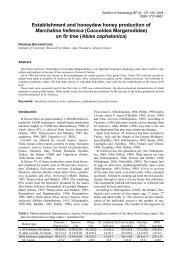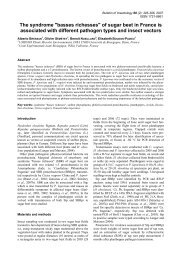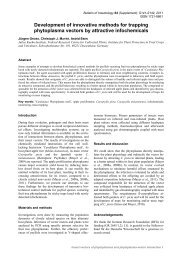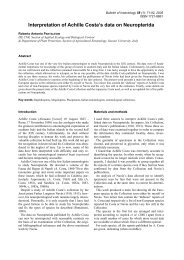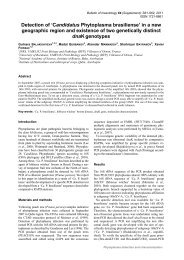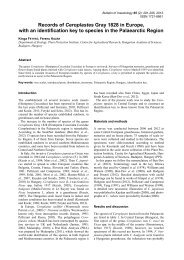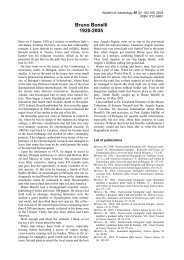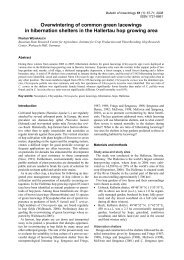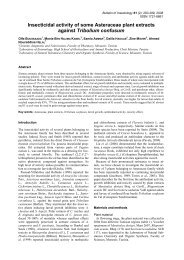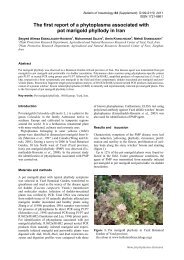Efficacy of kaolin, spinosad and malathion against Ceratitis capitata ...
Efficacy of kaolin, spinosad and malathion against Ceratitis capitata ...
Efficacy of kaolin, spinosad and malathion against Ceratitis capitata ...
You also want an ePaper? Increase the reach of your titles
YUMPU automatically turns print PDFs into web optimized ePapers that Google loves.
Mean number/tree<br />
44<br />
60<br />
50<br />
40<br />
30<br />
20<br />
10<br />
0<br />
Oct, 21 Oct, 29 Nov, 5 Nov, 11 Nov, 17 Nov, 24 Dec, 1<br />
Dates<br />
Kaolin Spinosad Malathion Control<br />
Figure 6. Mean number <strong>of</strong> dropped fruits per tree in Sidi Bouali orchard.<br />
Discussion<br />
This study aimed at verifying whether the organic insecticides<br />
<strong>kaolin</strong> <strong>and</strong> <strong>spinosad</strong> could be used instead <strong>of</strong> conventional<br />
agrochemicals for C. <strong>capitata</strong> control in Citrus<br />
orchards. In one trial, <strong>kaolin</strong> was more efficient than <strong>spinosad</strong><br />
<strong>and</strong> the insecticide <strong>malathion</strong>. Formulated <strong>kaolin</strong>,<br />
forming a particle film on plants, thus seems to be an<br />
important <strong>and</strong> helpful tool for the control <strong>of</strong> C. <strong>capitata</strong><br />
in Citrus groves. In Israel, Mazor <strong>and</strong> Erez (2004) conducted<br />
both laboratory <strong>and</strong> field tests with formulated<br />
<strong>kaolin</strong> (Surround WP), <strong>and</strong> obtained an almost complete<br />
protection on nectarine, apple, <strong>and</strong> persimmon <strong>against</strong><br />
infestations <strong>of</strong> the medfly. Kaolin also showed high efficacy<br />
in controlling an another Tephritid fly, the olive<br />
fruit fly, B. oleae, in olive groves in Syria (Saour <strong>and</strong><br />
Makee, 2003): fruit damage on <strong>kaolin</strong>-treated olive trees<br />
was significantly lower than on untreated control trees.<br />
Kaolin provided season-long insect control (> 14 weeks)<br />
outperforming the insecticide Dimethoate.<br />
As other species <strong>of</strong> the family Tephritidae, also adults<br />
<strong>of</strong> C. <strong>capitata</strong> are known for their flying foraging behaviour<br />
between trees <strong>and</strong> adjacent orchards (Prokopy<br />
<strong>and</strong> Roitberg, 1989). In our trials, experimental plots<br />
were side by side without buffer zone permitting free<br />
adult C. <strong>capitata</strong> movement <strong>and</strong> consequently a uniform<br />
fruit damage <strong>and</strong> relatively similar adult captures. This<br />
is true for <strong>spinosad</strong>-treated plots, <strong>malathion</strong> –treated<br />
plots <strong>and</strong> un-sprayed plots but not in <strong>kaolin</strong> treated plots<br />
where both damaged fruits <strong>and</strong> males captures were less<br />
important suggesting a relatively good protection <strong>of</strong><br />
<strong>kaolin</strong> treated trees.<br />
Many species <strong>of</strong> phytophagous arthropods use visual<br />
cues to locate their hosts (Owens <strong>and</strong> Prokopy, 1986).<br />
Tephritid fruit flies are attracted to colors <strong>and</strong> shapes<br />
reminiscent <strong>of</strong> host fruit <strong>and</strong> foliage. Katsoyannos (1989)<br />
tested seven colours in attracting C. <strong>capitata</strong> in Citrus<br />
orchards <strong>and</strong> found that the yellow colour was very attractive<br />
to fertilized females, whereas blue <strong>and</strong> white<br />
were the least attractive colours. Also Economopoulos<br />
(2002) stated that the preferred colour <strong>of</strong> C. <strong>capitata</strong> females<br />
is yellow, especially fluorescent yellow.<br />
Little research has been published on male C. <strong>capitata</strong><br />
preference for visual cue in traps baited with trimedlure<br />
probably because trimedlure is a such potent attractant<br />
(Nakagawa et al., 1971). Epsky et al., (1996) tested different<br />
colored inserts in Jackson traps baited with<br />
trimedlure <strong>and</strong> found that traps containing either yellow<br />
or orange inserts capture more C. <strong>capitata</strong> males than<br />
those with st<strong>and</strong>ard inserts.<br />
The trees, leaves <strong>and</strong> fruits treated with <strong>kaolin</strong> <strong>and</strong><br />
thus coated with a white particle film could influence<br />
the l<strong>and</strong>ing <strong>of</strong> females (Saour <strong>and</strong> Makee, 2003).<br />
In our trials, we did not find significant differences<br />
among treatments in the number <strong>of</strong> males captured in<br />
modified Steiner traps, probably due to (1) the high<br />
adult population level (figure 1, figure 4) <strong>and</strong> (2) the<br />
powerful attraction <strong>of</strong> males by the parapheromone<br />
trimedlure over relatively long distances (Cunningham,<br />
1989). Furthermore, the modified Steiner traps were<br />
yellow-orange in colour, <strong>and</strong> thus easy to locate for C.<br />
<strong>capitata</strong> adults.<br />
Saour <strong>and</strong> Makee (2003) suggested that the bright<br />
white colour <strong>of</strong> <strong>kaolin</strong>-sprayed olive trees may disrupt<br />
the orientation <strong>of</strong> the olive fruit fly, B. oleae, within the<br />
olive grove. However, the Authors did not support their<br />
hypothesis with data on female captures in MacPhail<br />
traps baited with bicarbonate solution.<br />
The use <strong>of</strong> the effective female trapping system consisting<br />
<strong>of</strong> McPhail traps baited with three synergistically<br />
acting food attractants (ammonium acetate, putrescine<br />
<strong>and</strong> trimethylamine) (Epsky et al., 1995; Heath et al.,



